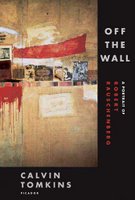Tuesday, February 21, 2006
Rauschenberg and the Art of Collaboration
 In between viewings of the Rauschenberg show at the Met, I've been reading Calvin Tomkins's recently reissued book, Off the Wall: A Portrait of Robert Rauschenberg.
In between viewings of the Rauschenberg show at the Met, I've been reading Calvin Tomkins's recently reissued book, Off the Wall: A Portrait of Robert Rauschenberg.Throughout the book Rauschenberg emerges as an anti-Romantic hero. There are plenty of scenes that show him working away in obscurity in his New York version of a garret. But rather than presenting him as an isolated, solitary genius whose vision changes the world around him, Tomkins shows Rauschenberg to be at his best when he's working in collaboration with others.
Throughout the book, Rauschenberg comes across as a catalyst, rather than a solitary creator. In his presence, objects, ideas, and the work of other artists engage and combine in ways that would not have been possible without him. Rauschenberg, meanwhile, loses none of his own creative power through the reaction.
This notion, artist as catalyst rather than creator, is the most interesting thing to emerge from Tomkins's work, but he stops a few steps short of completing the picture. Because, I believe, he and Rauschenberg have a long standing friendship and because Rauschenberg has always been reserved (if not secretive) about his personal life and his sexuality, Tomkins avoids going into detail on what could well be the most important story to be told about twentieth-century American art history--Rauschenberg's relationship with Jasper Johns.
Granted, there are several scenes in the book of these two as young men working in their studios a floor apart, critiquing each others' work, and sharing ideas. But this relationship coming as it did at such a crucial point in both artists' development really ought to be examined in more depth. Of their eventual falling out, Tomkins has only this to say:
They both went up to Connecticut College in the summer of 1962, to work with Merce Cunningham, who was there under the college's dance residency program. By the time the summer ended they were no longer together. The break was bitter and excruciatingly painful, not only for them but for their closest associates--Cage and Cunningham and a few others--who felt that they, too, had lost something of great value.And of the lifelong animosity that has remained between the two after their split, we get only this from Tomkins:
I would love to read a more detailed version of how these two worked together during the early-1960s as their individual styles developed and as they supported each other emotionally in the years before they began receiving market acceptance for their work. A detailed portrait of the relationship in these years would provide incredible new insight into the work of both artists and might even provide new thoughts on the nature of collaboration itself.Rauschenberg came to Johns's opening [for his 1977 Whitney retrospective], and at one point in the evening he even tried to tell Johns how he felt about seeing the paintings all together, but it was no use, they could not talk to each other any more on that level.
Sadly, though, there are only two people who could provide the detail necessary to write this account. And they're still not really speaking to (or about) each other.